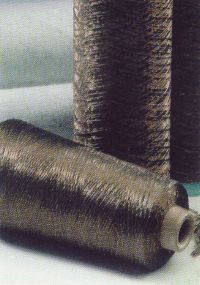
| ||||||||||
 |
Kindly note that this product is no longer in our program. Swicofil will try to find a suitable alternative.
Electrical conductivity in textiles
Applications of conductive textiles are more and more numerous in technical areas to satisfy functions such as heating, conduction, or EMI shielding, prevention of static chargers build-up. The electrical properties (conduction, resistance, etc.) are used in numerous solid materials, which are for the most part metal or metal derivates. In the textile field these properties are more difficult to highlight or engineer due to the various requirements in suppleness, handle and care proper to such materials.
Electrical conductivity and resistivity Electrical conductivity is the capacity of a material to allow the passage of an electrical current. Resistivity is the inverse of conductivity. One must distinguish the resistance (R) which characterizes a physical element and the resistivity which defines the intrinsic nature of the material constituting the element as two objects may be constituted of materials with different resistivity but share the same electrical resistance value in ohms. Ohm’s law defines the resistance (R) as the relation of the tension (U) applied to this element on the current (I) traversing it: R = U/I
One can distinguish three types of resistivity according to whether the material is presented in a linear, surface or volume format.
pl = R/L with R = resistance in ohms,
ps = R x 2 Pi /ln/r2/r1) with R = the resistance in ohms, r2 = the radius of the internal electrode,
pv = R x S/L with R = resistance in ohms,
A textile electro-conductor is characterized mainly by the measure of its electrical resistivity. The principle of this measure involves disposing on the sample some conductive electrodes, to the terminals of which is applied a tension in order to determine the resulting current. The resistivity derives from a calculation taking account of the current, the tension and the dimensions of the fitting. Numerous standards in different countries are based on this measurement principle. Here are two most used.
Conduction of textile surfaces The scale of electrical conduction covers a broad range, from surface resistivity of more than 1014 ohms down to resistivity of less than one ohm. The applications for conductor textiles are linked to this scale of resistivity. Applications involving the transport of electrical data, EMI shielding and heating textiles call for relatively low resistivity levels (less than 103 ohms), while the anti-statics are happy with performances of around 1010 ohms.
One can distinguish on the one hand conductive fibers and yarns, and on the other, those textiles which receive a conductive treatment on the finished product. Among the conductor fibers there are the intrinsically conductive fibers, along with polymer fibers on which is grafted a conductive function. In the first category one finds the fibers of metal or metallic alloys, as well as those of pure carbon. The fibers group, which is made conductive, is much broader, notably with all those fibers charged with carbon for antistatic applications. These fibers have a polymer base (polyester or polyamide for example), which is co-extruded with a polymer charged with carbon black. These products are generally used as grids during weaving to ensure a meshing, which ensures elimination of electrostatic charges. The applications for antistatic textiles are the most numerous, to include:
For applications calling for a lower resistivity (conduction, shielding or heating fabrics), one uses metallic fibers or directly metallized textiles. The family of conductor polymers, which are the naturally conductive plastics, is in full development by the major chemical industry groups (Bayer, Ormecon, DSM, etc.), and more new textile applications should thus be launched in the years to come.
R-stat
| |||||||||
| Be notified of page updates |
wwwswicofilcom2015

